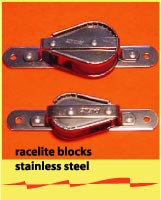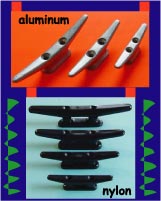An article written for our local Boat Club, the Gore Boat and Water Ski Club's June magazine, The Shoreline. The occasion of the outing was a mid Winter weekend trip up Lake Te Anau to a sheltered little bay called Safe Cove. After a day of fishing and site seeing on this beautiful lake we, all meet at Safe Cove to overnight. A big (safe) bonfire is lit in a small clearing just off the beech and a very convivial night is had before people retire to their boats for the night. Normally we awake to a good frost. More fishing and site seeing then before returning to the ramp and back to civilization.
I have always wanted some sort of safe heating for the boat as there were times when conditions have been miserable and there are only so many layers of clothes you can don especially when wearing a life jacket.
I tried buying one of those natty wee catalytic gas heaters only to be told they had been withdrawn from the market, and the fancy diesel burners were certainly outside my price range, so there was nothing else for it, I would have to make my own.
I went on the internet looking for a suitable sized stove that would fit in the rather confined space in my cabin but those available were still too large and quite expensive. Also the prophets of doom on the boating forums said we would all die in our beds from carbon monoxide poisoning so things weren't looking too flash. Then, I spied a posting by a pommy yachty who said he had made one out of box section steel and it worked a treat, so well in fact that he had to keep a port light open as it got too hot. He isn't dead yet either, at least not from CO poisoning. I set about designing my own. Using a 200mm section of 150 mm box section steel, I welded a top and a bottom of 3mm plate steel to the ends. Before doing the top weld I welded a deflector plate 25mm down from the top surface leaving a 25mm gap at the front for the smoke to travel up to the chimney. The latter is a length of stainless 50 mm pipe that fits into a flange welded to the top plate which has a 45mm hole cut in it at the back of the top plate.
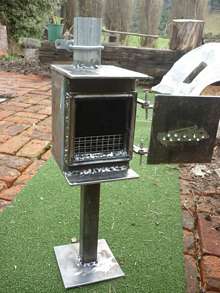 |
The raw beauty of it. |
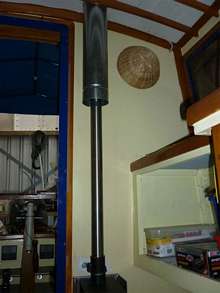 |
The cooling shrouds through the cabin roof.
|
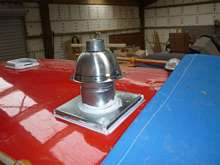 |
Stainless mixing bowl stops the water entering. |
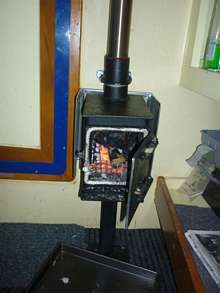 |
The roaring log fire.
|
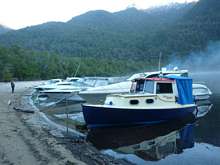 |
Red Setter making smoke. Looks worse than it was.
|
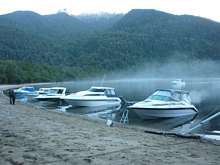 |
Safe Cove on Sunday morning. |
The door is has an opening 145mm high by 100mm wide and has a band of 20mm square with a recess to take the asbestos chord to make a seal. The door itself is 3mm steel with a mickey mouse hinge arrangement that swings away from the body of the stove. It seems to work OK. For air supply the door has about ten 6mm holes drilled through it and there are two holes in the back wall to help. Bearing in mind that I don't want the boat to burn down, I went to Dave at Southern Plumbing to pick his brains about shielding the stove from the surrounding woodwork. He offered to make up the necessary items and soon they arrived. At the rear of the stove are two stainless screens that are bolted with standoffs to the back of the stove. On the chimney where it exits the cabin top is a double layered pipe system with the outer one 140mm in diameter which is sealed to the cabin roof. To stop water coming in the cooling gaps is a fancy inverted stainless mixing bowl. The stainless chimney pipe can expand and contract at will in the cowling shrouds.
The stove sits on a 40mm box section pedestal screwed to the floor. Prevention of embers falling on the floor is a work in progress but initially one of Cook's best lamington trays was whisked away when she wasn't looking and has worked well so far. Since I only want to burn wood there is no need for a grate so the fire is set on a 20mm layer of sand.
I first lit up the fire while rafted up with four other boats on Friday night at Te Anau Downs. The other crews had their sharp knives handy in case they had to cut the burning hulk loose but it wasn't necessary and the fire worked a treat. Only the smoke was a bit antisocial but by then they were all so inebriated that it didn't matter. The fire worked even better on the Sunday morning at Safe Cove where we experienced a good frost with ice on the boats. Since the lake was like a millpond all day I fed the fire intermittently as I slowly made my way back to the ramp and extinguished it when the boat was on the trailer. There is a bit of tweaking required with the air supply but I am more than happy with the performance, the safety, and the cost of the fuel as I only used a shoebox of wood for the weekend.
On another note, I purchased a Carbon Monoxide monitor as a safety item and the only time it activated was on the trip home with the cabin door open and the outboard thundering along at 3500rpm. The directions say that when the alarm sounds there is life threatening quantities of CO present. You don't know these things eh? Problem was rectified by opening a forward port light and shutting the door.
|



